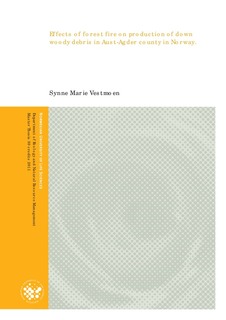| dc.description.abstract | Forest fires have played an important role in structuring the boreal conifer forest. Forest fires produce dead wood, which is important for biodiversity. Many species, including Red List species, are dependent on dead wood in general, and dead wood specifically from trees killed by forest fires. Human activities alter the natural forest cycle. Logging activities alter the forest by removing trees, and as a result much of the coarse woody debris (CWD) disappears. Fire suppression further reinforces this problem, as forest fires are effective producers of dead wood.
This thesis outlines the volume of down woody debris in forests that have been logged and burned (LB), logged but not burned (LNB), not logged and not burned (NLNB), and not logged and burned (NLB). Data was collected in Scots pine (P) and oak (O) dominated forests in the area around Mykland in Aust-Agder county in Norway. The thesis also connects the severity of the fire to the volumes found, and looks at down woody debris from before the fire and down woody debris created by the fire. Site index is also discussed. The sample plots were laid out in a random fashion, and the line intersect method was used to gather data on down woody debris.
NLBO has the highest mean value, followed by NLBP. The smallest mean value is found in NLNBP and LNBP. In most of the area that was logged and burned, the fire severity was medium or high, in most of the area that was not logged and burned, with Scots pine, the severity was high, while in most of the area that was not logged and burned, with oak, the severity was low. The smallest volume of pre-fire down woody debris was found in LBP, while the largest volume of pre-fire down woody debris was found in NLBO. The smallest volume of post-fire down woody debris was found in NLBO, while the largest volume of post-fire down woody debris was found in LB. The fire produced a lot of down woody debris in LBP, NLBP but not in NLBO. There is more down woody debris in areas with a higher site index. Apart from logging and the fire, the differences in down woody debris can be explained by the different topography, soil, tree species and so on. Previous forestry practice also affect the present down woody debris volumes. | en_US |
